This is yet another very photo-heavy blog from my next-to-last weekend in Nepal, which I spent successfully searching for Red Panda and birding on the eastern border of Nepal with India. My friend Mich, with whom I’m staying in Kathmandu, had been wanting to do this trip since long before he moved to Nepal for his job last year, having read trip reports on the website mammalwatching.com. Somehow during my stay he managed to magically finagle two and a half days off of work as well as get permission to be away from the family for a full four days.
To do this trip we actually bought a package private tour organized by the Red Panda Network (http://www.redpandanetwork.org), a non-profit with offices in the US and in Kathmandu. We had hoped it might be possible to do with the whole family, but after learning the finer details, such as the very rough jeep rides and extremely basic accommodations, it was decided by Mich and Kate that it wasn’t something we could take 23-month-old Mara and 3-month old Malcolm on. So Kate agreed to stay home with them, as long as Mich hired one of the nannies, the dear Saraswati, to stay with Kate while we were away. I hope Kate had as much fun with Mara as she did the previous weekend, but I know she really wanted to see the Red Panda too.
Red Panda Network made all of our arrangements including all food, transportation, and accommodation, starting with our flight from Kathmandu, a 40-minute flight to Bhadrapur in the lowlands of the far southeastern corner of the country on Wednesday, May 18.
We were accompanied during the whole trip by Sonam Lama, a biologist for the RPN in Kathmandu.
There was certainly some good birding possible in this lowland area – several lifers for Mich and me no doubt – but we needed to finish the first day’s travel with a few hours’ drive north to the town of Ilam, as famous in Nepal for its tea as Darjeeling is in India, which is close by and shares the exact same climate and soils. There wasn’t really that much good habitat along the roadside anyway, and some areas were long obliterated, wiped clean of their biodiversity to make way for tea plantations. We did hear Striated Prinias in this area.
But where there were a few patches of trees and scrub, and when we saw birds we made our driver stop a few times. This female Scarlet Minivet was at one stop.
We arrived in Ilam too late for any birding, but we were given a relaxed start Thursday morning, allowing us to see what was around near the hotel. There wasn’t much habitat at all, as we were right on the outskirts of the town, amidst tea plantations and family farms, far from any real forest.
Yet somehow, it was enough for a few nice birds, our favorite being this White-browed Piculet, closely related to the Rufous Piculet I saw in Borneo three years ago.
Another good bird was this Blue-throated Flycatcher.
I got my best photo yet of the stunning Velvet-fronted Nuthatch.
We then set off on a very rough 4-hour jeep ride on a narrow, steep, rocky, and muddy drive in a Land Rover utility vehicle almost as old as me to the little village of Dobato. At about the halfway point where we crossed the upper Mai River.
A lifer for both of us here was this Black-throated Prinia.
Yet another milkweed butterfly, this is Parantica tytia tytia, Chestnut Tiger.
We made only brief stops as the road began to climb a ridge eastward toward the Indian border. We paused for this White-throated Kingfisher.
At the same location we were surprised by two Woolly-necked Storks. Terraced mountain farms with flood irrigation doesn’t even come close to matching the habitat where I had seen my lifers just two years ago with Mich in northern Benin.
At noon on Thursday the 19th we arrived at our home for the next four nights, Dobato homestay.
There are only a handful of inhabited buildings in the village, whose name in the local language means something like “big crossroads.” The road is passable only with high-clearance 4WD vehicles, and has probably been in existence for only a few decades, while foot tracks from all regions have converge here for centuries, if not millennia. Due to the low relief right on the ridge, it’s a good area for farming, and most of the low bamboo shacks are mini barns for cows, goats, and chickens.
Here is a view of the lower part of the village from the forest trails.
We had a simple room with three hard beds in an unheated wooden house lined and roofed with a corrugated tin (we were advised to bring sleeping bags), and we had all our meals prepared by the family in the similar building next to it. The pit toilet was in a separate building behind, and a shower stall next to it was for taking a dip bath from a pail with water heated in the kitchen.
Our building
To make a long story short, with this first full afternoon and all day Friday and Saturday to find the pandas, we finally saw one mid-morning on Saturday. The latter half of Thursday was dominated by fog, and a team of 3 searchers hadn’t yet been sent out to find animals, and Mich and I were actually quite happy with exploring the area and seeing birds. We were ecstatic at finding this Black-headed Shrike-Babbler, a very scarce and elusive bird, seen by very few birders in Nepal.
Amazingly, on the same walk we saw Green Shrike-Babbler and Himalayan/Blyth's Shrike-Babbler – three Old World vireos on the same afternoon! Friday dawned gorgeous, and three panda trackers were out on the trails as were we, and Mich and I had a blast with the amazing birding in gorgeous habitat. But then fog came in quite early, and it began raining before noon, lasting until late afternoon. (We later found out that this was moisture from the not-so-distant Cyclone Roanu, which killed 125 or more people in Sri Lanka and Bangladesh.) We waited under an overhang for much of the afternoon, and the panda search was eventually called off.
A sign on the India border just as the rain began before noon.
A sign on the India border just as the rain began before noon.
On Saturday morning the weather was amazing and birding incredible – Satyr Tragopan, Slender-billed Scythe-Babbler, and Golden-breasted Fulvetta were birds Mich and I had only dared dream we might find here. I managed a blurry photo of the fulvetta, a specialist of bamboo in very moist high-elevation forests.
At 9:04 Sonam got a radio call from one of the trackers that he had located a panda, but we had to wait for another call before we found out where and which direction we should walk. After seven minutes fast walking down the ancient, well-traveled forest trail we were on, followed by twelve-and-a-half heart-pounding and breath-robbing minutes of climbing a side trail straight up a ridge though rhododendrons and bamboo (460 meters at a grade of 38% at an elevation of 2915 meters or 9560 feet!), and we were looking at one of the world’s rarest mammals, Ailurus fulgens, the Red Panda.
This is original panda, described to science a full 44 years before the Giant Panda, and supposedly named after what European collectors thought the locals were calling it (Frédéric Cuvier named it from specimens sent to him). The much more famous Giant Panda, as it turns out, is merely a member of the bear family, Ursidae, and had the original namers known that, they might have called it Pied Bear, Bamboo Bear, or some such thing and avoided associating it with this unique creature, which is deservedly the only panda. Like the bear, this mammal is unusual in eating bamboo as a major part of its diet, and it’s also in the order Carnivora, but it’s not closely related to any other species and is placed in its own family, Ailuridae, basal to the group of families that includes skunks, weasels, and raccoons. One of the odd things about its anatomy is that the hind foot can turn 90 degrees inward when it climbs, which it frequently does. In this photo you can barely make out that its right hind foot is turned toward us.
Here's a collage of videos I posted to Youtube:
The Dobato area is a remnant patch of forest that still exists largely because it’s too wet and steep to practice agriculture. Its only a few hundred hectares immediately adjacent to India’s much larger Singalila National Park, and that’s why there are still Red Pandas here.
There are only five or six territories on the Nepal side, with another six or so in smaller patches of the upper Mai River drainage. The animal is truly critically endangered worldwide, with poaching at least as serious an issue as habitat loss, and we feel assured that our contribution as ecotourists will help to keep this population fragment a bit safer. More people should include this as a side trip to their visit to the Himalayas. We were grateful to the local forest guardians for their hard work. Sonam made sure all were out in force – Nima Dawa Sherpa, Pinju Sherpa, and Dev Limbu were the main trackers.
The view of higher peaks on the ridge to the north of Dobato were tantalizing. At 3200 meters or higher, they surely had a few new birds for us, maybe Blood Pheasant. They’d have to wait until the next visit.
This geometrid moth was in our room one night; it is in the genus Photoscotosia, probably P. miniosata.
We had lunch both full days at the tiny village of Kaiyakata right on the international border. Our first day there was a solid wall of fog (as the rain began), and the second day clouds came and went. There was a constant stream of international and Indian tourists, most of whom probably had no idea they were in Nepal when they stopped for tea.
The road is the border with West Bengal, India at Singalila National Park.
Here’s a sampling of the birds we saw.
Rusty-flanked Treecreeper (a hard bird to photograph in the dark afternoon fog). In this photo you can see the uninterrupted bright white surround to the dark ear covers that is distinctive in this species.
Rufous-gorgeted Flycatcher
Darjeeling Woodpecker
Black-browed Tit, closely related to our Bushtit
Eurasian Nutcracker (a bit of a surprise, as there are no conifers here)
Red-tailed Minla
Scaly Laughingthrush
White-collared Blackbird
Yellow-browed Tit
This Red Crossbill was particularly exciting. I heard it as it flew over, in and out of the fog on the Indian border. I managed to queue it up on my iPod quickly enough to encourage it to turn around and land. I even got some recordings of its calls, which matched the Himalayan subspecies (or species) I had downloaded from Xeno-Canto. I remarked how much it sounded like our small-billed Douglas-fir crossbill from the Pacific Northwest. Amazingly, even the sonogram looks very close, a V-shape at the exact same frequency.
Stripe-throated Yuhina – one of the most abundant birds here.
Rufous-vented Tit
White-browed Bush-Robin female
Green-tailed Sunbird male
Green-tailed Sunbird female
Ashy-throated Warbler – the most abundant of the Phylloscopus warblers (we also had many Blyth’s Leaf Warblers and several Large-billed Leaf Warblers).
Olive-backed Pipit, only in the farm fields of corn, potato, and cauliflower.
Yellow-billed Blue-Magpie eating leeches from a cow (I managed to avoid getting any leeches, though Mich had one on his sock).
A video of the behavior, though I didn't get the parts that showed it preferred blood-engorged leeches:
Verditer Flycatcher – common in the farm fields, at forest edge, and deep within the pristine forests.
Common Hawk-Cuckoo, at a stop on our way back on Sunday.
Of course I was crazy about the amazing plants here, some of which I recognized as exotics used in landscaping in my western Oregon home, including some Daphne and Cotoneaster, neither of which was blooming. More exotic, and oddly not planted in Oregon, though surely hardy, were a couple orchids:
Pleione hookeriana
Coelogyne corymbosa – the same orchid blooming in Shivapuri National Park near Kathmandu
This is obviously a species of rose (Rosa), but it was free of any fragrance.
A strawberry flower and fruit, Fragaria sp., sadly lacking in a distinctive flavor.
This strange shrub looked like a rhododendron at first glance, but I noticed it had male and female flowers on separate plants, and some already had very non-Ericaceous fruits. I’m still searching for an ID. (Update 6/8/16: Sonam has found it for me: Daphniphyllum himalense, in the family Euphorbiaceae)
male flowers
female flowers
fruit
There were a few species of true rhododendrons here, but the only one still barely in bloom was this Rhododendron falconeri.
Viburnum erubescens
An unknown pink shrub
Spiraea arcuata
While we were waiting for the rain to slacken on Friday afternoon, we waited under an overhang along the trail and I noticed this algae, which looks very much like the Trentepohlia sp. I had seen on the Curry County coast of Oregon a couple years ago – a species which usually associates with a fungus to become a lichen.
There were also an abundance of filmy ferns (family Hymenophyllaceae) here.
I saw at least two species of cobra lilies here. This is Arisaema intermedium with amazingly long extensions to the spathe and spadix.
This is Arisaema griffithi, with an oddly ribbed interior of the spathe.
This earwig was inside the flower.
This is Enkianthus deflexus, related to blueberries. It reminded me of the shrub Menziesia ferruginea in Oregon.
I recognized this Berberis aristata as one common in cultivation.
Viola sikkimensis
I haven’t identified this kiwi-like flower, possibly in the Chinese-gooseberry family, Actinidiaceae
The Lycopodium, clubmoss here looks exactly like species in the New World, perhaps not surprising for such an ancient plant.
This bizarre plant was utterly new for me: Holboellia deflexa, in the crazy sounding family Lardizabalaceae (Lardizabal is a Basque surname). It turns out be a small family native mostly from the eastern Himalayas to Japan, but with two oddball species in temperate South America. The flowers are cauliflorous, borne directly on the woody vine stems that get lost in the densely mossy shrubbery and forest floor. Only a few leaves were visible here and there, looking like a Schefflera or something else in Araliaceae, but obviously not even closely related to that family. I was told the ripe fruits are edible.
We spent Sunday traveling back to Kathmandu, starting with 3 ½ hours by rough jeep ride, mostly through farmed country. One crop grown in this region is the ginger relative Amomum subulatum, black cardamom.
This orchid Dendrobium amoenum was common in the trees at this more temperate altitude.
In Ilam we said goodbye to Sonam and the forest guardians who had been tracking for us.
After another 3 ½ hours on paved highway we were back at the Bhadrapur airport for our flight back to Kathmandu.





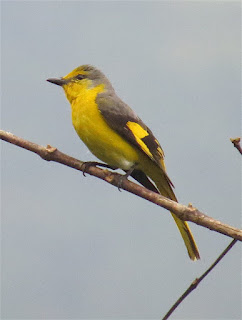







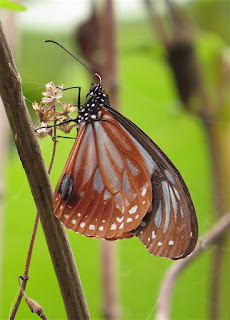




























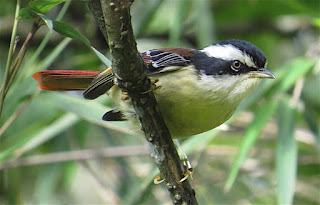


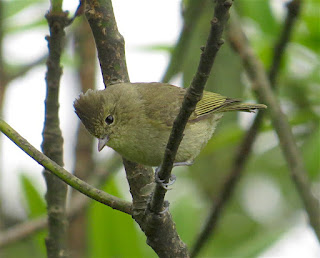








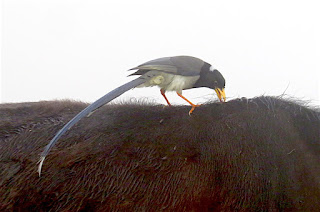
















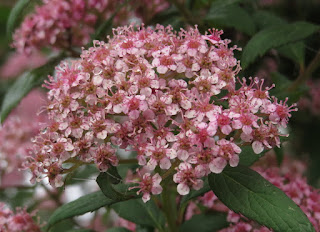



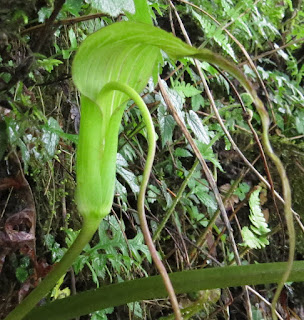






















No comments:
Post a Comment